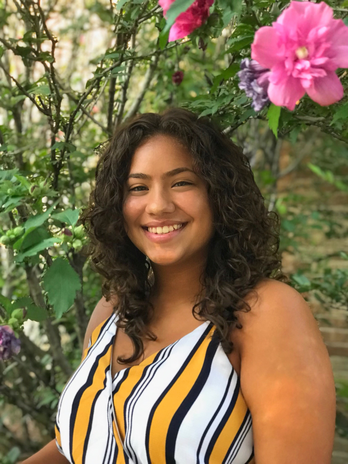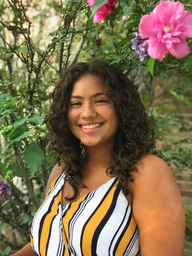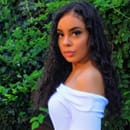Art has been trying its subtle ways to bring people together even when there is a difference in opinions. A form of expression and implication, art can lead you into realising the malice and goodness of the society around us. The people, the environment and all societal parts, influence each other and nothing exists in isolation. J’Lynn Vellon (JV), a Puerto Rican raised in the westside of Chicago, who is Double Majoring in Psychology and Studio Art at Agnes Scott College, understands this concept well. I interviewed J’Lynn about how art has influenced her life and the result of it.

VC: How did you develop your appreciation for art?
JV: I think I always felt that it was something that I liked but as far as an appreciation for it, I think of museums. In Chicago they have a museum called The Art Institute of Chicago, among other great museums, but I didn’t go often which made me appreciate it more when I did get to go. In high school when I was able to look at those different pieces, different mediums, and being able to think about how the artist got there and what they’re trying to tell me- that’s always something that gets me into it, what does this mean- I was able to grow to appreciate it more.
VC: Is that when you began to draw?
JV: No, I’ve always drawn. Kids have crayons and colored pencils, and they start drawing but I just never stopped.
VC: How was art important to your development?
JV: Processing emotions really was something that sometimes I could really only do with art. In highschool, a lot of my friends’ dads died and though it didn’t happen to me and they were able to deal with it in their own ways to eventually be okay, it was something that was so heavy to me and I could only express that through drawing a picture about it. That’s when I realized that I need art to survive, deeply. I also had a friend in high school who died as a result of gun violence and I was able to heal from that through making a piece dedicated to him.
VC: So would you say that art helps you navigate the world?
JV: Absolutely. Definitely, but also it helps me navigate my own emotions. I think that’s pretty important too.


VC: Boricua, we are both from the same island and I know that my identity influences the way I perceive life and connect with others. Does art make you feel connected to your culture as a Latin American woman?
JV: Oh my gosh, yes. In high school I went to a small Puerto Rican museum and there were a lot of pieces depicting things that only a Puerto Rican person would understand as far as the titles and concepts. In that sense it does but I think it could make me feel even more connected if I continue to explore it and dabble into that cultural aspect.
VC: Would you be interested in pursuing and creating art specific to Puerto Rican culture?
JV: I would! My high school was a very wealthy school, very up North, and we needed to make a ceramic piece and think of a place to put it, the purpose for putting it there. I wanted to make congas– this was when Puerto Rico was literally shaking. I was sad because my school was so big but it was predominantly white and the minority was Hispanic, and even more so Puerto Ricans, so no one was talking about the earth quakes and I felt so alone cause I’d go home, think about it, go to sleep, think about it, wake up and go back to school, and I’d still be thinking about it. But no one ever said anything. So I wanted to make three congas, but they were going to be flower planters and have cracks in them. They were going to have the Taíno symbols on them, like the frog and the sun- different symbols like that but they were going to have cracks all through them to represent what was happening. That was something I was really excited about- I am so proud about being Puerto Rican and I really love art but it wasn’t until that moment that I had ever really considered putting those two concepts together.

VC: With that said, in what ways is art relevant and important to society?
JV: The same way that I can have an emotional experience and an emotional connection to art, someone else can also connect in that way to an art piece, even if they’re not the ones that are making it. There are some things that you just can’t express in words and then sometimes seeing something, getting a tidbit of what the artist meant by the creation of that piece, it’s like wow. You feel it, kind of like music.
VC: How does that reflect in your own art?
JV: Given that I know that it’s possible for the viewer, who has no connection to the art, to still relate to it and feel things because of it, I make art with a purpose. Sometimes people will be like yeah I made that because I thought it was nice and I liked it but then I’ll be like what does it mean though? Does it mean anything? And I just don’t understand how to make artistic decisions without having a specific purpose behind those decisions. Everything has a purpose when I make art.

VC: Quarantine last year was hard for everyone socially, economically, and obviously for health reasons as well. How did art have a role in you navigating through the pandemic and processing everything that was going on in the world during that time?
JV: The pandemic was hard for many obvious reasons so for a while I shut myself off from it because I…actually, I don’t know why… But I know that when I wanted to do things with my family, I thought to myself oh I have all this paint, we can have a Bob Ross date [laughter]. For my 18th birthday, it was the first day that everything shut down. Everyone started quarantine on my birthday so painting something with everyone was a part of it. I was able to do something a little different with my family, however, I was too upset about what was happening to try to even express it through art.
VC: Absolutely. The effects of the pandemic are still being felt today, especially for those in our age group who graduated during the pandemic. One moment we were half-way through senior year and in the blink of an eye, we were college sophomores. We will never forget that and are still trying to understand the depth of that impact, yet we were able to find mediums which we used to disconnect from the chaos. For you that was art, and having the opportunity to share that with your family.
JV: So true, well-being was not uniformly felt across society.
VC: Given that art has molded you as a person, will you pursue art as a career, why or why not?
JV: My parents have very high expectations of me in terms of getting a job with really good money [laughter]. They want for me to able to make good money, be able to take care of myself, and be able to take care of my future family so I never really considered being a freelance artist or just someone who sells art for a living, but I have considered doing art therapy with children since I’m also interested in psychology. I obviously won’t be painting extravagant pieces with these little kids but it is still something creative that I could possibly end up doing.
VC: If not within your career, will you continue to create your own art throughout your adulthood?
JV: Absolutely. As I said before, I literally need it. [laughter]
Art allows us to see new perspectives on our world, our emotions, and our possible futures. It guides us on powerful journeys in ways that are often safer than real life, but which can impact our real lives positively nonetheless, especially through the healing process of post pandemic trauma and grief. Art brings us through richly imagined scenes and emotions that expand us and allows us to connect with our own selves, our own identities, even in intangible ways. To follow J’Lynn through her academic trajectory and journey within art, you can find her on Instagram: @jmvellon5.



